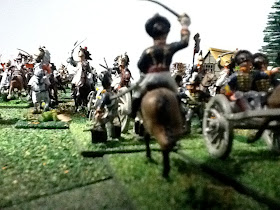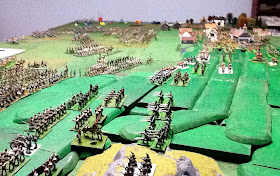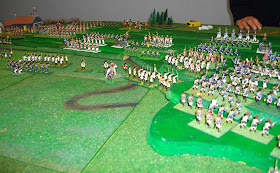This is quite a long report, so you may wish to get a glass, bottle or perhaps a carton (!) of your favourite tipple while you sit back and read about the miniature mayhem.
The Game
We used our own scenario of Fuentes de Oñoro for these games. The scenario incorporated the two days of battle plus the re-organisation that occurred on 4th May. We added several special rules to provide for the special 'flavour' of this amazing battle; the terrain and town, rivalry between Marshals Massena and Béssières, the presence of Don Julian Sanchez and some of his guerrilla lancers, understrength units, French converged grenadiers, the pause in combat on 4th May and shortage of ammunition for Massena's army. We have posted the scenario on google docs, so click on this link to view/download the document.
We played these games using the Shako II rules in their entirety, including the optional rules for impacts of and risks to divisional commanders (via staff officers), but with one exception. The calculation for divisional morale totals and morale check levels were done as per original Shako, using the MR of the individual units rather than merely the number of units in a division. This was the first of several reversions to original Shako that, along with our own rules, we have included in Shako ANF.
(13th ANF game, played 31st July & 3rd August 2011)
In our first version of the game, I took the French and Mark the Anglo-Portuguese (no surprises there). Given the historical starting point, I attacked more or less as Massena did on 3rd May; cavalry on the left, Loison’s corps attacked the town while Junot’s small corps and Reynier’s corps were launched at the angle in the centre of the ridge and the British left (Campbell & Erskine).
Below is a description of the first day of battle (and of our game), firstly in photos followed by a written summary.
Day 1, 3rd May 1811
Looking south along the Anglo-Portuguese position, with Erskine's division in the foreground. Fuentes de Oñoro can be seen in the distance.
Spencer's division defending Fuentes de Oñoro.
Sanchez's guerrillas in and around Nave de Haver.
Montbrun's dragoons made short work of Sanchez's lancers; battlefield fighting not their best role.
The French attack with Marchand’s division followed by Mermet’s (both from Loison's VI Corps) closest to camera, with Junot’s VIII Corps (the solitary division of Solignac) and Reynier’s II Corps (Merle’s and Heudelet’s divisions) in the distance.
Reynier's Corps (Merle’s division in front) attacked Erskine’s men on the northern end of the ridge, while to their left Junot (Solignac)‘s command took on Campbell.
View of same from Anglo-Portuguese lines.
Junot (Solignac)'s to the right, then Heudelet’s and Merle’s divisions viewed from Campbell's lines. Note the stagger markers caused by the French artillery, which should aid the attacking French.
Faced with an imposing looking onslaught, Spencer's troops stood strong in their position in and around Fuentes de Oñoro.
A local offered his blessing...
To the lads of the 95th who were amongst the defenders.
While the Guards stood tall before the walls of Fuentes de Oñoro.
Above and below: Merle’s men made their first attack against Erskine’s defensive line.
As Solignac’s drove at the "hinge".
Marchand’s division made their first attack on the British Guards in front of Fuentes de Oñoro.
Above and below: at the southern end of the battlefield, good early progress was made by Montbrun's dragoons against Cotton's artillery and cavalry.
Above and below: the Guards easily repulsed Marchand’s 6e légère.
At the northern end of the battlefield the attack of Merle’s 2e légère was also repulsed...
but the next ‘wave’ came on.
Not deterred by the initial set-backs, the next line of Marchand’s men attack the British Guards (1/Colstream).
Having dispersed Cotton's cavalry brigades, Montbrun's dragoons followed up their against Houston's division.
Mermet's division attempted to attack around the right of Spencer’s position; the 25e légère coming off second best against another battalion of Guards (1/Scots).
Two more battalion's from Marchand's division in retreat after coming off second best against the 1/Colstream Guards.
Merle’s attack stalled before the solid defence from Erskine’s line.
At long last success for the French infantry: before Fuentes as the 1/Colstream Guards were finally dispersed by fire from Loison's fresh division, and
Merle's division created a gap in Erskine's line.
Meanwhile on the southern flank Montbrun's cavalry came up against Houston's squares and 'bounced'!
Summary of Day 1
Above and below: the battlefield from the north after the redeployment of 4th May. D'Erlon's corps is out of photo behind Reynier's. British still comfortably in control of the ridge and town.
View from the south-west showing the renewed attacks by Junot’s and Reynier’s corps on Campbell/Erskine and Loison’s corps on Fuentes de Oñoro. Note d’Erlon’s corps’ flanking movement in the left foreground and the French grand battery in the centre.
Ashworth’s independent Portuguese brigade head north to bolster the left flank.
Déjà vu? Loison’s divisions attack Fuentes de Oñoro.
View of the battlefield from the south. Guard cavalry at right foreground; will Lépic allow them to be involved, will Béssières be found?
What remained of Montbrun’s cavalry kept the infantry of the British right flank in square.
Déjà vu all over again as the lead units of Loison’s division retreated from Fuentes de Oñoro.
Barbacena’s 4th/10th Portuguese cavalry charged to support the brigade’s horse artillery battery which was under attack from 4/54e ligne, breaking the French infantry. In a disciplined display, they rallied back to join Ashworth’s infantry.
As on the first day of battle, Reynier launched Merle’s division at Erskine’s line while Solignac’s division of Junot’s corps attacked Campbell’s division (at left).
After the first attack was repulsed, Campbell’s men counter-attacked Solignac’s Régiment de Prusse.
Viscount Wellington was calm and confident.
After the long march around the flank d’Erlon’s lead troops (Claparède’s division) entered the fray at the extreme northern end of the battlefield...
which was still held by Barbacena’s weak cavalry brigade and a battery of Portuguese foot artillery.
Back on the southern flank, Montbrun’s cavalry and horse artillery menaced Houston’s division,...
while Mermet's division supported by Lamotte's light cavalry and horse artillery easily accounted for the Gordon highlanders on Spencer’s right.
The light division manoeuvred behind the lines, having been sent by the Duke to sure up his left.
All remained fairly calm in the west of Fuentes de Oñoro,
as Loison’s men gathered for the hoped-for final, successful attack,
some angling to the north of the town to take advantage of the gap left by Picton’s division which had withdrawn away from the French grand battery.
Above and below: although outflanked, Spencer’s men remained calm and confident in their strong position in the town.
Meanwhile in the north, Heudelet’s troops, emboldened by the flank support of Claparède’s division, drove at Erskine’s line.
The ‘unit of the day’, Barbacena’s 4th/10th Portuguese cavalry, charged and broke the 4/21e légère (Claparède).
Erkine’s line held firm,...
the 2/30th Foot showing great mettle (yes, we know that the actual regiment had yellow facings).
Summary of Day 2 (Version 1)
My plan has sort of worked. It took about three hours for d'Erlon's troops to be in position to attack, but they did cause Wellesley to move troops to the left flank—especially the Light Division which "did a Bernadotte" (or d'Erlon at Ligny/Quatre Bras) and marched between the two flanks, so as not to be engaged. Meanwhile, Junot and Reynier began to wear down the Anglo-Portuguese on the ridge and a gap started to form. Loison was bashing his head (well those of the troops in his division anyway) hopelessly against Fuentes de Oñoro, but Mermet's division, which had been ordered to attack around the southern flank of the town, made some progress, taking advantage of the pressure created by the remnants of Montbrun's division and Lamotte's light cavalry. That was to be the 'high tide mark' of the French attacks.
French casualties began to tell so that, as the ammunition began to run low, it was clearly evident that the attacks could only fail.
Result (Version 1)
The first run of the battle was a fairly 'bloody' struggle in which the French were only able to make small indents into the Anglo-Portugese position. d'Erlon's corps was threatening to turn the northern flank and Mermet's division supported by Fournier's light cavalry and the remnants of Montbrun's dragoons was making some headway around the southern side of Fuentes de Oñoro. However, the Anglo-Portugese position in the the town was secure, the northern end of the ridge was still held strongly and they had ample reserves, chiefly in the form of the Light Division that had seen no action to date. The French attack was called when an objective assessment of the weakened, 'fragile' divisions and low ammunition showed that they were unlikely to get much farther.
The French received nine victory points at battle's end (13:30 turn on 5th May); one point for controlling Nave de Haver, two points for controlling Poço Velho and six points for having broken two of Stapleton-Cotton’s cavalry brigades. The Anglo-Portuguese received sixteen; ten points for controlling Fuentes de Oñoro and six points for the breaking Merle’s division and Soult P.’s cavalry brigade. The difference of seven meant a major victory to the Anglo-Portuguese. Looking at the broken units, the French had lost 110 points of MR from an army of 260 points (42%), while the Anglo-Portuguese had lost 63 MR points from an army of 246 (26%).
It had been an intriguing game. The French had caused a little discomfort to the Anglo-Portuguese, but had never really challenged for victory.
There were many highlights such as the 'dead-eye' Anglo-Portugese artillery, a last hour of combat in which both sides had devastating volleys (i.e. rolled sixes), breaking several units and the fact that Massena was able to 'find' Béssières so as to be able to use the guard cavalry. They saw no action though as they were still manoeuvring into position when the attack was called off.
The battle honours had to belong to Barbacena’s small brigade of Portuguese cavalry and artillery battery which almost single-handedly held the Anglo-Portuguese left flank. Three well-executed charges from the under-strength Portuguese dragoons saw off Phil Soult’s chasseur à cheval (also under-strength) on 3rd May and helped to slow the attack by Claparède’s division of d’Erlon’s corps on the 5th; saving the artillery battery in the process. The artillery battery was eventually overrun by a battalion of French infantry late on 5th May (12:00), but the dragoons ended the battle in good order, supporting Ashworth’s independent Portuguese brigade to hold the left flank!
What would happen in version two?





























































Hi James!
ReplyDeleteI came several times to read in full this superb report...glad to see this brave Portuguese army, and glad to see this very nice looking battle!
Thank you Phil. Hopefully you will find version two interesting too.
Delete